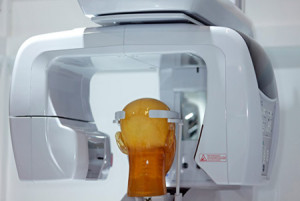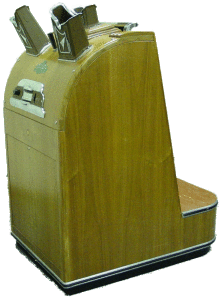November 25th, 2015
Looking and Finding
Harrison Reed, PA-C
I sat in the bulky padded chair and eyed the mechanical gadgetry around me.
“What did you say this was for?” I tried to not sound confrontational, but there must be some deformity of my vocal cords that makes it hard.
“It’s called a CT scanner,” the dental technician said. “It takes pictures so we can look at your mouth and throat.”
She had missed the meaning of my inquiry but it wasn’t her fault. She didn’t know how familiar I was with the test, how I had ordered dozens—hundreds maybe—already this year and used the results to guide someone else’s fate. She didn’t know that I was usually the one wearing the scrubs and I was in no hurry to point it out.
No one wants to be that guy.
 “Right, but what exactly are we looking for?” Annoyance started to creep into my voice. It was my first appointment with a new dentist and I’m a terrible dental patient. Maybe it’s all the work I had on my teeth as a kid or maybe it’s those bright overhead lights and the stiff, mechanized chairs. Or maybe life is just easier for the examiner than the examined.
“Right, but what exactly are we looking for?” Annoyance started to creep into my voice. It was my first appointment with a new dentist and I’m a terrible dental patient. Maybe it’s all the work I had on my teeth as a kid or maybe it’s those bright overhead lights and the stiff, mechanized chairs. Or maybe life is just easier for the examiner than the examined.
“Well, it’s important to check your neck for any masses, anything that could be wrong with your airway,” she said. “Just to be safe.”
Right, I thought. An asymptomatic, healthy 20-something needs a CT of the neck to be safe from… what exactly?
“Hold still.” The machinery began to hum and whirl.
I wondered how many scans each year the small dental office needed to charge to afford its own CT scanner, but I didn’t say that out loud. Besides, there was nothing sinister about this place. Humans, in general, just seem to have an obsession with looking.
I’m guilty of that inquisitive trait, too. Isn’t everyone who pursues science? But lately I’ve shifted my focus past what we could look for and started wondering if we should.
Blasphemy, I know. After all, we deal in the currency of knowledge; get as much information as you can and figure out what to do with it later. But we’ve already stumbled across the risks of looking.
Shoe-fitting fluoroscopes—gimmicky x-ray boxes that claimed to match shoppers with the perfect footwear—were once popular in 1950s shoe stores.1
And just as the government finished pulling those hazardous contraptions from sales floors, medicine entered a new era: the Age of Radiography. The invention of the computed tomography (CT) scanner launched an obsession with looking inside the human body at all costs. Even if that price included, among other things, cancer.2
Of course, we have since weighed both sides of the ledger and, along with the improvement of alternate imaging techniques, now see the first signs of a decline in CT imaging.3 Maybe that means medicine has begun to appreciate the dangers of looking.
But what about the dangers of finding?
They weren’t on my mind when the huddled form of my 89-year-old patient rolled into the emergency department. She had fallen at home and smacked her wrinkled forehead on the kitchen tile. Now she arrived with three generations in tow—a living, breathing family tree that wanted to ensure its eldest member was OK.
Their expectant faces asked a question with only one right answer: everything is normal.
But today that wasn’t true. Like any responsible clinician, I ordered a CT of her head to look for a bleed. I didn’t find one. Instead, those x-rays shooting through her skull revealed something else: a tumor.
The old lady left my care that afternoon as she was whisked off to the hospital ward for more tests. But I had spent enough time in the ICU to know what happens to a 90-year-old body subjected to the needles and blades and poisons of modern medicine. And I wondered if her fate would have been better if I had never looked inside her head that day.
As that little bundle of blankets and age rolled away from my exam room and our eyes met for the last time, I knew what she was looking for: clarity, serenity, peace.
I just wished medicine was better at finding it.
- Dyson, E. D. (4 August 1956). “Shoe Fitting X-Ray Fluoroscopes: Radiation Measurements and Hazards” (PDF). British Medical Journal 2 2 (4987): 269272
- Miglioretti DL, Johnson E, Williams A, et al. (2013) The Use of Computed Tomography in Pediatrics and the Associated Radiation Exposure and Estimated Cancer Risk. JAMA Pediatr. 167(8):700-707. doi:10.1001/jamapediatrics.2013.311.
- Levin, David C. et al. (2012). The Recent Downturn in Utilization of CT: The Start of a New Trend? Journal of the American College of Radiology, Volume 9 , Issue 11 , 795 – 798

; [/php]/images/AU000_hreed.jpg)


Dear Almost a Doc. – you almost got it right – there is no clinically valid (or justifiable) explanation for your radiation dose from that panoramic dental X-Ray.
Radiation causes cancer – period. Random CAT scans will, randomly, produce significant findings – but more likely non-significant findings, or false positives. There’s now a large literature in the radiology journals about how we “forgot the children”: in terms of our radiation dosing of them – this is how it happens.
P.S. Would you have allowed this to be done to your child?
Next time demand to have your dentist personally justify the test – “will it change your clinical management of the case?” “Just to check” is medico-legal language for shifting the (cost and risk) burden onto the patient!!
Dear Max,
Thank you for reading and, more importantly, taking the time to comment and highlight some of the points I made in the blog. I did have a discussion with my dentist about all of the pros and cons of imaging and set up a plan with her for decisions regarding any diagnostics. I hope the anecdote didn’t distract too much from the larger point.
And for future reference, I’m not “almost a Doc,” but I’m definitely a PA-C. I’m happy that this blog is able to introduce us to readers who are not as familiar with the profession.
Thanks for your support and keep reading In Practice!
-Harrison
Would like to read more on this topic.
Leesa,
Plenty of recent study and literature is focusing on ways to reduce radiographic testing as both a cost-saving and safety measure. In addition, many editorials and blogs frequently discuss this topic, especially in my field of emergency medicine. Happy reading!
-Harrison